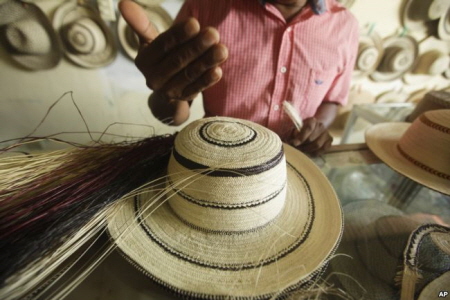
   |
[Headlines] (HL-예술/취미/종교) UNESCO Recognizes Panama's Hats
최고관리자 | 17-12-29 00:35

The United Nations Educational, Scientific and Cultural Organization (UNESCO) has recognized the artisans of Panama for their woven hats. Cultural authorities have added the pintao, or painted hat, to UNESCO's List of the Intangible Cultural Heritage of Humanity. “The pintao hat has become an integral part of regional outfits throughout the country worn during traditional dances and community festivities,” UNESCO's statement said. The pintao is different than the widely known “Panama hat.” The Panama hat has a wide brim. It is traditionally made in Ecuador from the straw of the toquilla palm plant. It is thought to have earned a misleading name during the Gold Rush in the 19th century. Many were sold in nearby Panama to people traveling to California in search of gold. Artisans make the pintao by hand. They use five different plants and even a small amount of dirt to create it. The hat industry's center is in La Pintada, a district about 170 kilometers west of Panama City.
* recognize = 공인[승인]하다/ artisan = 장인, 기능 보유자/ woven hat = 짠[엮은] 모자/ Intangible Cultural Heritage of Humanity = 인류무형유산/ integral = (전체를 구성하는 일부로서) 필수적인, 필요불가결한/ regional outfit = 지방[지역]의 옷[복장]/ wide brim = 넓은 챙/ straw = 짚, 밀짚; (한 올의) 짚, 지푸라기/ by hand = (기계가 아닌) 사람 손으로
Reinaldo Quiros is a well-known artisan and designer who sells hats out of his home. “They don’t have anything (artificial), no machinery; no factory as such exists here in La Pintada," he said. “Each artisan in his own home makes the hats maintaining the techniques taught by his ancestors.” Artisans of the truly Panamanian pintao hat start with the fibers of several plants. They cure and then weave the fiber into braids. Then, they wrap the braids around a wooden form and sew it together from the crown of the hat down. Depending on the quality of the work, some pintao hats can cost hundreds of dollars. Authorities estimate that 4,000 of La Pintada’s 25,000 residents work creating or selling the hats. Pedro Mendoza, a 50-year-old hat maker, hopes that the UNESCO recognition will help take the pintao hat beyond the country’s borders. “It’s really good what’s happened,” he said. “The hat for us is a way of life.”
* well-known = 유명한, 잘 알려진/ ancestor = 조상, 선조/ fiber = 섬유; 섬유질, 섬유 조직; [식물] 수염뿌리/ cure = 식품・담배를 훈연, 소금 절임 등으로) 보존 처리를 하다/ weave = (옷감・카펫・바구니 등을) 짜다[엮다], 짜서[엮어서] 만들다/ braid = (실을 꼬아서 만든) 장식용 수술/ a[the, sb's] way of life = (~의) 생활 방식
   |




